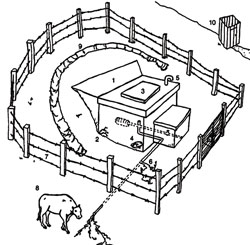16.6 Sanitary survey of springs
When a spring is chosen for a water supply, the sanitary survey should determine that the water quality is acceptable, the quantity of water available is adequate to meet the needs of the community and the spring is protected from contamination. The quantity of water available from a spring can vary significantly due to changes in groundwater storage.
Like wells, springs should have protective devices such as good fences and warning signs to discourage human and animal activities that might disturb the spring area. The spring box or storage tank and cover need to be watertight to prevent undesirable water from entering. Since most springs never stop producing water, an overflow is needed to ensure that water pressure does not build up and damage the spring box. The end of the overflow drain should have a screen to prevent the entrance of animals. Springs should have a diversion ditch located at the uphill end of the site which keeps rainwater from flowing over the spring area. A good impervious barrier, such as clay or a plastic liner, can help ensure high quality water by preventing potential contaminants from entering the collection facilities. Figure 16.4 shows what you should be looking for when you are doing a sanitary survey of a spring and Box 16.2 has a list of questions to be asked. The numbers in the diagram demonstrate particular points and correspond to the questions in the checklist.

Box 16.2 Sample checklist for protected spring source inspection
Name of Health Post ------------
Village name ------------
Questions to be asked during survey:
- Is the spring source open to any contamination?
- Is the stonework protecting the spring broken anywhere?
- Could contaminants get into the box through the inspection hole?
- Does the spring box have any contaminating silt?
- If the spring box has an air vent, could it let in any contaminants?
- If the spring box has an overflow, is it unsanitary (unclean)?
- Is the area around the spring unfenced?
- Do animals have access to within 15 m of the spring source?
- Is a diversion ditch above the spring absent or non-functional?
- Are there any latrines uphill of the spring?
Name ------------
Signature ------------
Date ------------
16.5 Sanitary survey of wells
